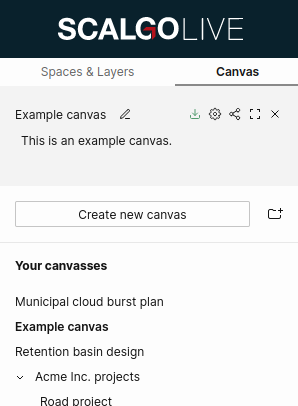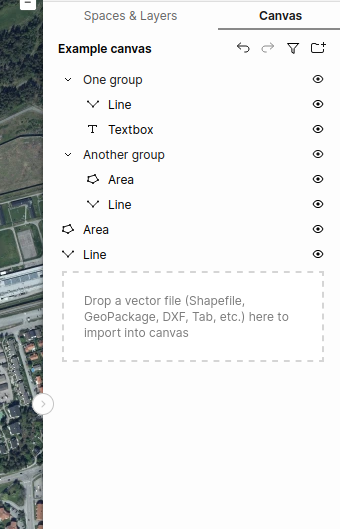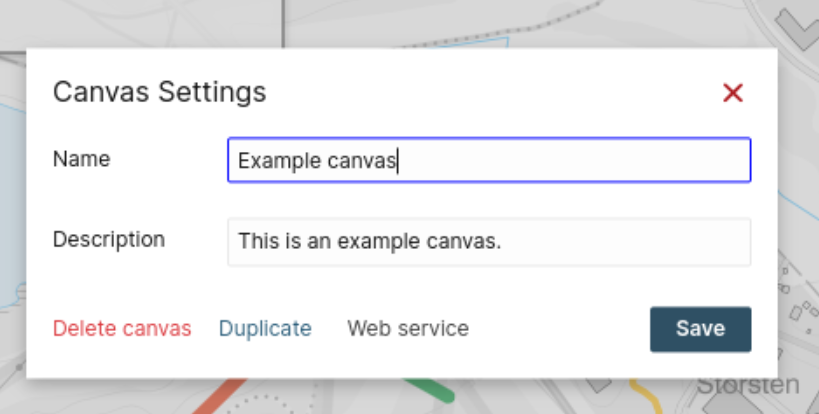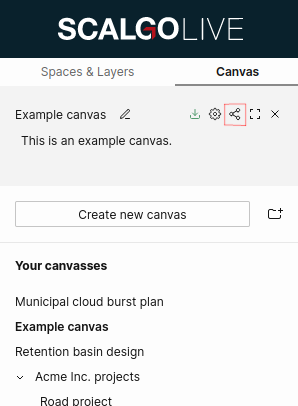-
Documentation
-
About
- Getting Started & Use Cases
- Support
-
What's New
- Simplified tools for designing with contour lines
- DynamicFlood: Organize and understand your computations
- Modelling stormwater networks in Scalgo Live
- National US high-resolution land cover map
- New functionality for CAD users!
- DynamicFlood: Cleaning up rain events and adding historical rains, now available in France
- National Polish high-resolution land cover map
- DynamicFlood now available in Great Britain
- Global contour maps now available
- Updated Swedish topsoil map
- Scalgo Live Global theme is updated with new elevation and land cover data
- Detailed culvert information in DynamicFlood
- No more Lantmäteriet fees for Swedish data
- Depth-dependent surface roughness (Manning) in DynamicFlood
- Detailed land cover map for all of Great Britain
- National French high-resolution land cover map
- Work with multiple features simultaneously in the canvas
- Spill points on flash flood map and depression map
- New surface roughness (Manning) parameters for DynamicFlood
- Workspace and Modelspace sharing updates
- Regionally varying rain in DynamicFlood Sweden
- Veden imeytyminen nyt osana rankkasadeanalyysejä
- Use Scalgo Live anywhere in the world
- DynamicFlood: Live model speed info and regionally-varying rain events
- Sea-level rise: Download building flooding information
- Detailed contour maps and editable buildings in Workspaces
- New in Modelspaces: Explore hydrodynamic simulations and visualise the dynamics of flow velocity
- National German high-resolution land cover map
- Specify basins and protrusions by drawing their outer boundary
- Simplified path features
- National Norwegian high-resolution land cover map
- Organise and communicate on a digital canvas
- New sidebar to help organize your analyses and queries
- Sliding contours
- Ny skyfallsanalys och en ännu bättre marktäckekarta
- New land cover map for Finland
- Depths in the depression map
- New Danish land cover map with more classes
- National Swedish High-Resolution Impervious Surface Mapping
- Watershed tool updated with even better descriptions of catchment characteristics
- National Flash Flood Map with Infiltration and Drainage for Denmark
- Add your own WMS layers to SCALGO Live
- Enriched building data in Denmark
- National hydrological corrections and Land Cover for Poland
- National hydrological corrections for Norway
- Updated Impervious Surface Mapping for Denmark
- National hydrological corrections and updated local data for Finland
- Fast and intuitive tools to work with infiltration and land use
- Improvements to vector imports and exports
- National Danish groundwater model
- New Sweden high-resolution model
- New powerful depression map and more analyses visualization options
- Introducing Modelspaces: Get your hydrodynamic models into SCALGO Live
- Use case videos
- Access a EA flood maps inside SCALGO Live
- Improved map export
- New powerful ways to edit the elevation model
- Better coloring of flooding layers and sea-level depth filtering
- National Danish High-Resolution Impervious Surface Mapping
- National access for local and regional organizations
- Simpler, more powerful downloads
- Customize Layer Transparency
- Hydrological corrections and new data in Sweden
- Improved export functionality
- Access a wide range of authorative data inside SCALGO Live
- Importing VASP data
- Measure gradients, undo edits, and Norway updates
- New terrain edit features, soil balance information and much more...
- Browse historical orthophotos in SCALGO Live
- Emergency planning with sea-level rise from national forecast data
- Detailed information about watershed composition
- Better styling of imported vector layers
- New Danish Elevation Model
- Work with gradients in the profile widget
- Flood risk screening from rivers and flow paths
- New workspace tool: Raise and lower terrain uniformly
- Importing LandXML TINs, LAS point clouds
- New model in Sweden
- Side slopes on workspace features
- Drag and drop enhancements
- Swedish contour maps
- Subsurface basins and sewage drains in workspaces
- New Interface
- Volume information for watersheds and flow paths
- New powerful tool for emergency response and coastal flood prevention
- Denmark: New flash flood map
- Sweden: Geodatasamverkan setting for Swedish users
- Import custom terrain models
- New Hydrological Corrections
- Elevation contours now available
- Download orthophotos as JPEG and PNG
- Subsurface structures in workspace
- Sea-levels in terrain profiles
- Updated orthophotos
- Models and analysis update
- User interface updates
- User interface updates
- GeoDanmark/FOT data, Matrikelkortet now available
- New flash flood map
- Download of risk polygons
- Updated orthophotos
- Nationwide hydrology on the new DHM/2015 model now available
- New flash flood map computation available with watershed download
- DHM/2015 variants and sea-levels now available nationwide
- DHM/2015 now available nationwide
- Hydrology on the new DHM/2015 model now available
- New DHM/2015 Model - now with buildings
- New DHM Model
- Watershed Tool
- Ad hoc layers
- Nationwide contour maps for all countries
- Single Sign-On
- Data Fees
- User Interface
- Canvas
- Analysis
- Workspaces
- Modelspaces
- Working with CAD data
- Core+ DynamicFlood
- Core+ NatureInsight
- Core+ PropertyResilience
- Streams and Flow
- Physical Properties
- Country Specific
-
About
Canvas – Creating and Managing
For high-level information about the SCALGO Live Canvas, please consult the product page. Some of the topics on this page are also referenced in the canvas getting started video.
To select an existing canvas, or create a new one, you need to switch to the Canvas tab in the left sidebar. The currently-active canvas will be shown on top.

You can create folders to better organize your canvasses.
Basic canvas usage
Once you activate a canvas a couple of things will happen:
- The canvas toolbar will appear on the map, this is used for drawing and editing the canvas.
- The canvas object list becomes available in a tab on the right sidebar. It is not activated by default.
- The top of the canvas tab in the left sidebar will highlight the selected canvas.

SCALGO Live with an activated canvas. Notice the toolbar and the activated canvas tab in the right sidebar.
In the right sidebar you will find the Canvas tab which gives you a list of all the objects in your canvas. You can create groups for organizing your objects.

When hovering the mouse on an item in this list you can:
- Select object by clicking on it.
- It is possible to select multiple objects. When holding down CTRL you can toggle the selection of individual objects and with SHIFT you can add multiple objects to your current selection
- Toggle the visibility of the object or currently selected objects
- Zoom to the object
- Drag the object to a different position in the hierarchy
- Delete the object
- Access a menu with additional options, including:
- Buffering the object: provided a distance we can produce a polygon that is a buffered version of the original object - a polygon whose extent is bigger than the original object by the provided distance. This may not be available for all objects.
- Convert the object type to something else. Some special object types (e.g. imported watershed queries from the watershed tool) disallow the editing of the individual vertices, but by converting these objects into standard areas, you can edit the vertices again. Beware: there may be too many vertices to comfortably edit by hand.
Canvas settings
In the selected canvas area in the left sidebar, you can access additional canvas options and manage sharing of your canvas. The additional canvas options (in the gear menu) allow you to:
- Change the name and description of the canvas
- Delete the canvas
- Duplicate the canvas (sharing settings are not duplicated)
- Get the link to the canvas webservice for integrating the canvas with GIS

Sharing
In the active canvas dialog you can also access the sharing settings where you can share your canvas with other SCALGO Live users.

When you share a canvas with a user, you can choose to give the user full access to the canvas. With this they can edit and draw on the canvas, but also manage sharing and delete the canvas. You can also choose to give users read-only access to a canvas. If you have read-only access to a canvas you can only see the canvas, but not edit and draw on it. You are also unable to share or duplicate it.
When you share a canvas with a user, they will receive an email notification.